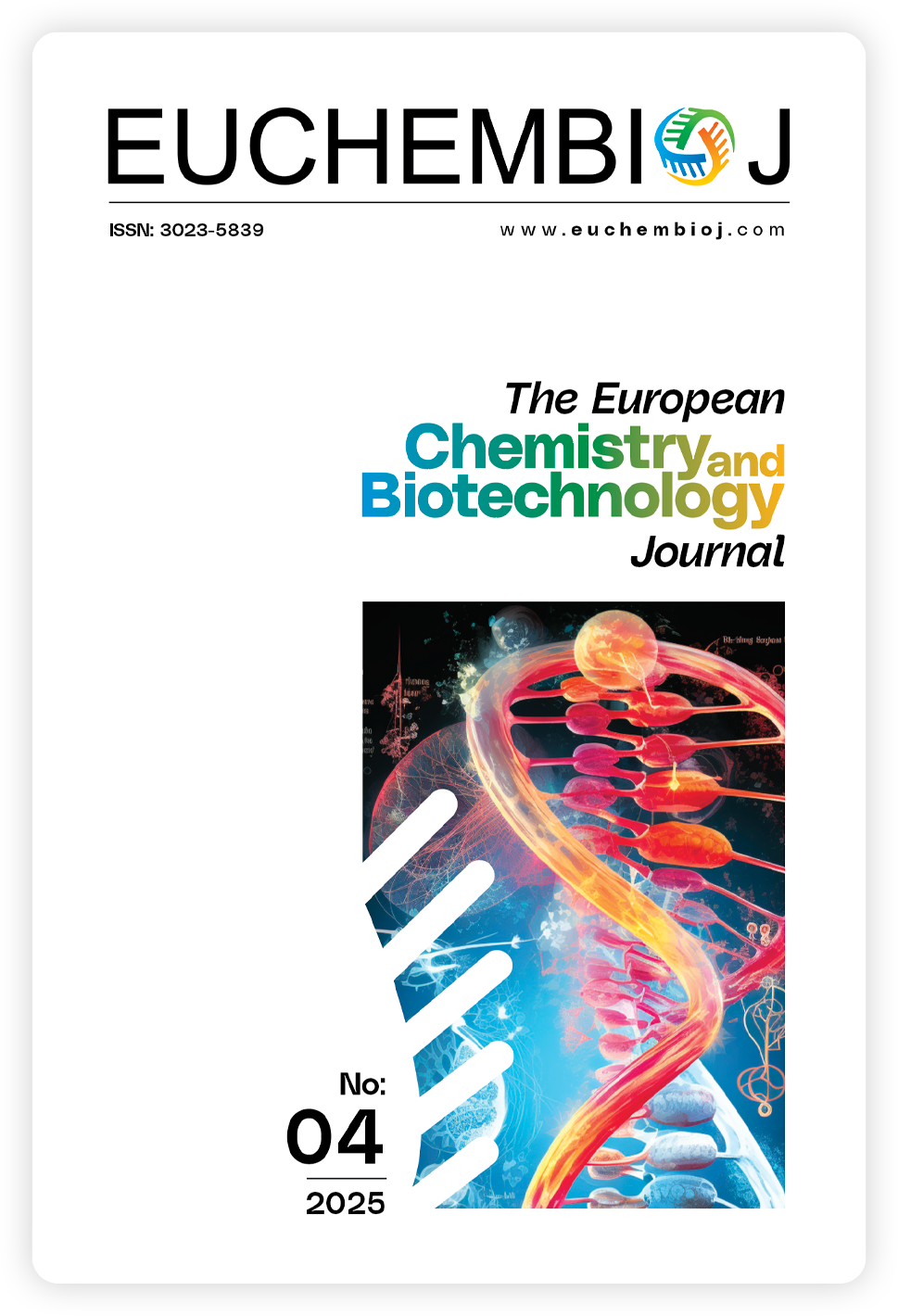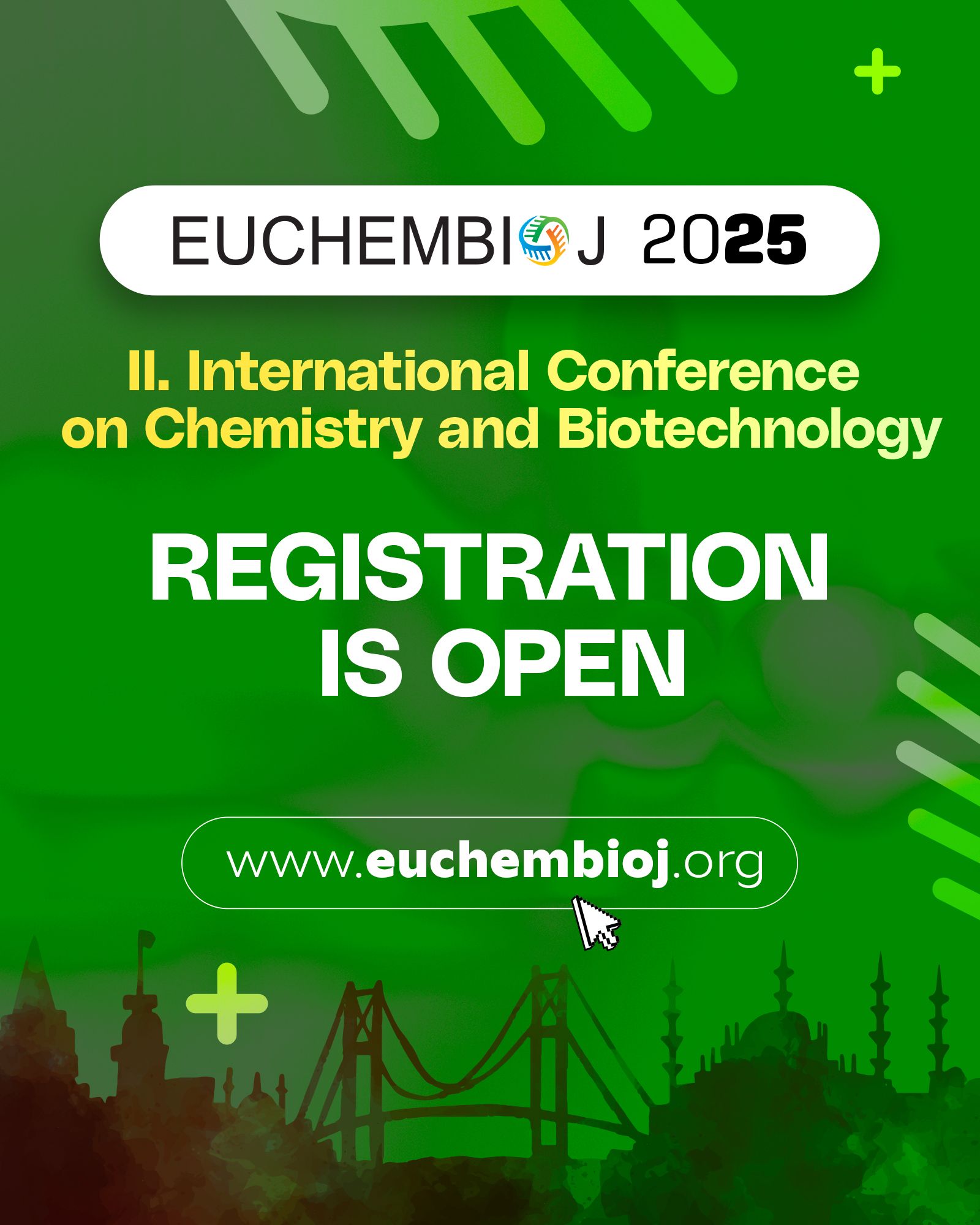Identification of new candidate molecules against SARS-CoV-2 through docking studies
DOI:
https://doi.org/10.62063/ecb-40Keywords:
Coronavirus, in silico, molecular docking, drug developmentAbstract
The recent outbreak of a new coronavirus disease known as COVID-19, caused by Severe Acute Respiratory Syndrome Coronavirus 2 (SARS-CoV-2), is a highly contagious and pathogenic viral infection that has spread worldwide. Coronaviruses are known to cause disease in humans, other mammals, and birds. Although specific therapeutics and vaccines require efforts in this direction, reaching the world's population with mutations of the virus can be a difficult target. The major proteases of coronavirus play a critical role during the spread of the disease and therefore still represent an important target for drug discovery. As of now, there is still no official treatment for infected patients. In this study, bioinformatics-based molecular docking studies were performed to identify potent inhibitors of novel candidate molecules against the spike protein S of SARS-CoV-2. The affinities of ligand molecules thought to be effective in the treatment of SARS-CoV-2 disease were investigated. For this purpose, 1,615 different FDA-approved drug ligand molecules were retrieved from ZINC15 database. Crystallographic structure of spike protein S of SARS-CoV-2 was retrieved from Protein Data Bank (PDB). Initial virtual screening was performed using qvina-w, an accelerated version of AutoDock Vina optimized for rapid docking, to evaluate binding affinities of all 1,615 compounds against the spike protein. The top 10 ligands with the most favorable binding affinities were selected for further analysis. These ligands were docked to the target protein with Autodock Vina. The complexes were first solvated and then run through Molecular Dynamics (MD) simulations, utilizing NAMD. The binding energies were computed through these interactions, which are used to compare the affinities of the ligands to the target protein. Ultimately, 10 different ligands capable of inhibiting the spike protein of SARS-CoV-2 were selected and compared based on their affinities.
References
Armstrong, J., Niemann, H., Smeekens, S., Rottier, P., & Warren, G. (1984). Sequence and topology of a model intracellular membrane protein, E1 glycoprotein, from a coronavirus. Nature, 308(5961), 751–752. https://doi.org/10.1038/308751a0 DOI: https://doi.org/10.1038/308751a0
Beniac, D. R., Andonov, A., Grudeski, E., & Booth, T. F. (2006). Architecture of the SARS coronavirus prefusion spike. Nature Structural & Molecular Biology, 13(8), 751–752. https://doi.org/10.1038/nsmb1123 DOI: https://doi.org/10.1038/nsmb1123
Bestle, D., Heindl, M. R., Limburg, H., Pilgram, O., Moulton, H., Stein, D. A., Hardes, K., Eickmann, M., Dolnik, O., Rohde, C., Klenk, H. D., Garten, W., Steinmetzer, T., & Böttcher-Friebertshäuser, E. (2020). TMPRSS2 and furin are both essential for proteolytic activation of SARS-CoV-2 in human airway cells. Life Science Alliance, 3(9), e202000786. https://doi.org/10.26508/lsa.202000786 DOI: https://doi.org/10.26508/lsa.202000786
Bhattacharya, S., Banerjee, A., & Ray, S. (2021). Development of new vaccine target against SARS-CoV2 using envelope (E) protein: An evolutionary, molecular modeling and docking based study. International Journal of Biological Macromolecules, 172, 74–81. https://doi.org/10.1016/j.ijbiomac.2020.12.192 DOI: https://doi.org/10.1016/j.ijbiomac.2020.12.192
Bosch, B. J., Van der Zee, R., De Haan, C. A., & Rottier, P. J. (2003). The coronavirus spike protein is a class I virus fusion protein: Structural and functional characterization of the fusion core complex. Journal of Virology, 77(16), 8801–8811. https://doi.org/10.1128/JVI.77.16.8801-8811.2003 DOI: https://doi.org/10.1128/JVI.77.16.8801-8811.2003
Daina, A., Michielin, O., & Zoete, V. (2017). SwissADME: A free web tool to evaluate pharmacokinetics, drug-likeness and medicinal chemistry friendliness of small molecules. Scientific Reports, 7, 42717. https://doi.org/10.1038/srep42717 DOI: https://doi.org/10.1038/srep42717
Eberhardt, J., Santos-Martins, D., Tillack, A. F., & Forli, S. (2021). AutoDock Vina 1.2.0: New docking methods, expanded force field, and python bindings. Journal of Chemical Information and Modeling, 61(8), 3891–3898. https://doi.org/10.1021/acs.jcim.1c00203 DOI: https://doi.org/10.1021/acs.jcim.1c00203
Fehr, A. R., & Perlman, S. (2015). Coronaviruses: An overview of their replication and pathogenesis. In H. J. Maier, E. Bickerton, & P. Britton (Eds.), Coronaviruses: Methods and Protocols (pp. 1–23). Humana Press. https://doi.org/10.1007/978-1-4939-2438-7_1 DOI: https://doi.org/10.1007/978-1-4939-2438-7_1
Frenoy, P., Perduca, V., Cano-Sancho, G., Antignac, J. P., Severi, G., & Mancini, F. R. (2022). Application of two statistical approaches (Bayesian Kernel Machine Regression and Principal Component Regression) to assess breast cancer risk in association to exposure to mixtures of brominated flame retardants and per- and polyfluorinated alkylated substances in the E3N cohort. Environmental Health, 21(1), 27. https://doi.org/10.1186/s12940-022-00817-0 DOI: https://doi.org/10.1186/s12940-022-00840-4
Garg, M., Maralakunte, M., Garg, S., Dhooria, S., Sehgal, I., Bhalla, A. S., Vijayvergiya, R., Grover, S., Bhatia, V., Jagia, P., Bhalla, A., Suri, V., Goyal, M., Agarwal, R., Puri, G. D., & Sandhu, M. S. (2021). The conundrum of 'Long-COVID-19': A narrative review. International Journal of General Medicine, 14, 2491–2506. https://doi.org/10.2147/IJGM.S316708 DOI: https://doi.org/10.2147/IJGM.S316708
Hamming, I., Timens, W., Bulthuis, M. L. C., Lely, A. T., Navis, G. V., & van Goor, H. (2004). Tissue distribution of ACE2 protein, the functional receptor for SARS coronavirus. A first step in understanding SARS pathogenesis. The Journal of Pathology, 203(2), 631–637. https://doi.org/10.1002/path.1570 DOI: https://doi.org/10.1002/path.1570
Humphrey, W., Dalke, A., & Schulten, K. (1996). VMD - Visual Molecular Dynamics. Journal of Molecular Graphics, 14(1), 33–38. https://doi.org/10.1016/0263-7855(96)00018-5 DOI: https://doi.org/10.1016/0263-7855(96)00018-5
Hurst, K. R., Koetzner, C. A., & Masters, P. S. (2013). Characterization of a critical interaction between the coronavirus nucleocapsid protein and nonstructural protein 3 of the viral replicase-transcriptase complex. Journal of Virology, 87(16), 9159–9172. https://doi.org/10.1128/JVI.01075-13 DOI: https://doi.org/10.1128/JVI.01275-13
Kamimura, A., Umemoto, H., Kawamoto, T., & Honda, T. (2021). Development of water solubility of 2-phenylsulfanylhydroquinone dimer dye. ACS Omega, 6(13), 9254–9262. https://doi.org/10.1021/acsomega.1c00507 DOI: https://doi.org/10.1021/acsomega.1c00703
Kitchen, D. B., Decornez, H., Furr, J. R., & Bajorath, J. (2004). Docking and scoring in virtual screening for drug discovery: Methods and applications. Nature Reviews Drug Discovery, 3(11), 935–949. https://doi.org/10.1038/nrd1549 DOI: https://doi.org/10.1038/nrd1549
Kumawat, P., Agarwal, L. K., & Sharma, K. (2024). An overview of SARS-CoV-2 potential targets, inhibitors, and computational insights to enrich the promising treatment strategies. Current Microbiology, 81, 169. https://doi.org/10.1007/s00284-024-03615-1 DOI: https://doi.org/10.1007/s00284-024-03671-3
Kuo, L., & Masters, P. S. (2013). Functional analysis of the murine coronavirus genomic RNA packaging signal. Journal of Virology, 87(9), 5182–5192. https://doi.org/10.1128/JVI.03478-12 DOI: https://doi.org/10.1128/JVI.00100-13
Lan, J., Ge, J., Yu, J., Shan, S., Zhou, H., Fan, S., Zhang, Q., Shi, X., Wang, Q., Zhang, L., & Wang, X. (2020). Structure of the SARS-CoV-2 spike receptor-binding domain bound to the ACE2 receptor. Nature, 581(7807), 215–220. https://doi.org/10.1038/s41586-020-2180-5 DOI: https://doi.org/10.1038/s41586-020-2180-5
Letko, M., Marzi, A., & Munster, V. (2020). Functional assessment of cell entry and receptor usage for SARS-CoV-2 and other lineage B betacoronaviruses. Nature Microbiology, 5(4), 562–569. https://doi.org/10.1038/s41564-020-0688-y DOI: https://doi.org/10.1038/s41564-020-0688-y
Li, Y., Surya, W., Claudine, S., & Torres, J. (2014). Structure of a conserved Golgi complex-targeting signal in coronavirus envelope proteins. Journal of Biological Chemistry, 289(18), 12535–12549. https://doi.org/10.1074/jbc.M113.528487 DOI: https://doi.org/10.1074/jbc.M114.560094
Molinspiration. (2015). Calculation of molecular properties and bioactivity score. http://www.molinspiration.com/cgi-bin/properties
Neuman, B. W., Kiss, G., Kunding, A. H., Bhella, D., Baksh, M. F., Connelly, S., Droese, B., Klaus, J. P., Makino, S., & Buchmeier, M. J. (2011). A structural analysis of M protein in coronavirus assembly and morphology. Journal of Structural Biology, 174(1), 11–22. https://doi.org/10.1016/j.jsb.2010.11.021 DOI: https://doi.org/10.1016/j.jsb.2010.11.021
Nieto-Torres, J. L., DeDiego, M. L., Verdiá-Báguena, C., Jimenez-Guardeño, J. M., Regla-Nava, J. A., Fernandez-Delgado, R., Castano-Rodriguez, C., Alcaraz, A., Torres, J., Aguilella, V. M., & Enjuanes, L. (2014). Severe acute respiratory syndrome coronavirus envelope protein ion channel activity promotes virus fitness and pathogenesis. PLoS Pathogens, 10(5), e1004077. https://doi.org/10.1371/journal.ppat.1004077 DOI: https://doi.org/10.1371/journal.ppat.1004077
Payne, S. (2017). Family Coronaviridae. In Viruses (pp. 149–158). Academic Press. https://doi.org/10.1016/B978-0-12-803109-4.00017-9 DOI: https://doi.org/10.1016/B978-0-12-803109-4.00017-9
Petersen, E., Koopmans, M., Go, U., Hamer, D. H., Petrosillo, N., Castelli, F., Storgaard, M., Al Khalili, S., & Simonsen, L. (2020). Comparing SARS-CoV-2 with SARS-CoV and influenza pandemics. The Lancet Infectious Diseases, 20(9), e238–e244. https://doi.org/10.1016/S1473-3099(20)30484-9 DOI: https://doi.org/10.1016/S1473-3099(20)30484-9
Phillips, J. C., Hardy, D. J., Maia, J. D. C., Stone, J. E., Ribeiro, J. V., Bernardi, R. C., Buch, R., Fiorin, G., Hénin, J., Jiang, W., McGreevy, R., Melo, M. C. R., Radak, B. K., Skeel, R. D., Singharoy, A., Wang, Y., Roux, B., Aksimentiev, A., Luthey-Schulten, Z., Kalé, L. V., Schulten, K., Chipot, C., & Tajkhorshid, E. (2020). Scalable molecular dynamics on CPU and GPU architectures with NAMD. The Journal of Chemical Physics, 153(4), 044130. https://doi.org/10.1063/5.0014475 DOI: https://doi.org/10.1063/5.0014475
Rarey, M., Wefing, S., & Lengauer, T. (1996). Placement of medium-sized molecular fragments into active sites of proteins. Journal of Computer-Aided Molecular Design, 10(1), 41–54. https://doi.org/10.1007/BF00124466 DOI: https://doi.org/10.1007/BF00124464
Rogers, D. M., Agarwal, R., Vermaas, J. V., Durrant, J. D., Welborn, V. V., Kireev, D., & Luthey-Schulten, Z. (2023). SARS-CoV2 billion-compound docking. Scientific Data, 10, 173. https://doi.org/10.1038/s41597-023-02148-0 DOI: https://doi.org/10.1038/s41597-023-01984-9
Schoeman, D., & Fielding, B. C. (2019). Coronavirus envelope protein: Current knowledge. Virology Journal, 16, 69. https://doi.org/10.1186/s12985-019-1182-0 DOI: https://doi.org/10.1186/s12985-019-1182-0
Sharma, V., Rai, H., Gautam, D. N. S., Prajapati, P. K., & Sharma, R. (2022). Emerging evidence on Omicron (B.1.1.529) SARS-CoV-2 variant. Journal of Medical Virology, 94(5), 1876–1885. https://doi.org/10.1002/jmv.27526 DOI: https://doi.org/10.1002/jmv.27626
Stohlman, S. A., & Lai, M. M. (1979). Phosphoproteins of murine hepatitis viruses. Journal of Virology, 32(2), 672–675. https://doi.org/10.1128/jvi.32.2.672-675.1979 DOI: https://doi.org/10.1128/jvi.32.2.672-675.1979
Walls, A. C., Park, Y. J., Tortorici, M. A., Wall, A., McGuire, A. T., & Veesler, D. (2020). Structure, function, and antigenicity of the SARS-CoV-2 spike glycoprotein. Cell, 181(2), 281–292.e6. https://doi.org/10.1016/j.cell.2020.02.058 DOI: https://doi.org/10.1016/j.cell.2020.02.058
Wang, Q., Qiu, Y., Li, J. Y., Zhou, Z. J., Liao, C. H., & Ge, X. Y. (2020). A unique protease cleavage site predicted in the spike protein of the novel pneumonia coronavirus (2019-nCoV) potentially related to viral transmissibility. Virologica Sinica, 35, 337–339. https://doi.org/10.1007/s12250-020-00206-5 DOI: https://doi.org/10.1007/s12250-020-00212-7
Wang, Y., Grunewald, M., & Perlman, S. (2020). Coronaviruses: An updated overview of their replication and pathogenesis. In H. J. Maier, E. Bickerton, & P. Britton (Eds.), Coronaviruses: Methods and Protocols (pp. 1–29). Humana. https://doi.org/10.1007/978-1-0716-0327-7_1 DOI: https://doi.org/10.1007/978-1-0716-0900-2_1
Xia, S., Liu, M., Wang, C., Xu, W., Lan, Q., Feng, S., Qi, F., Bao, L., Du, L., Liu, S., Qin, C., Sun, F., Shi, Z., Zhu, Y., Jiang, S., & Lu, L. (2020). Inhibition of SARS-CoV-2 (previously 2019-nCoV) infection by a highly potent pan-coronavirus fusion inhibitor targeting its spike protein that harbors a high capacity to mediate membrane fusion. Cell Research, 30(4), 343–355. https://doi.org/10.1038/s41422-020-0305-x DOI: https://doi.org/10.1038/s41422-020-0305-x
Xiu, S., Dick, A., Ju, H., Mirzaie, S., Abdi, F., Cocklin, S., Zhan, P., & Liu, X. (2020). Inhibitors of SARS-CoV-2 entry: Current and future opportunities. Journal of Medicinal Chemistry, 63(21), 12256–12274. https://doi.org/10.1021/acs.jmedchem.0c00502 DOI: https://doi.org/10.1021/acs.jmedchem.0c00502
Published
How to Cite
Issue
Section
License

This work is licensed under a Creative Commons Attribution-NonCommercial 4.0 International License.








